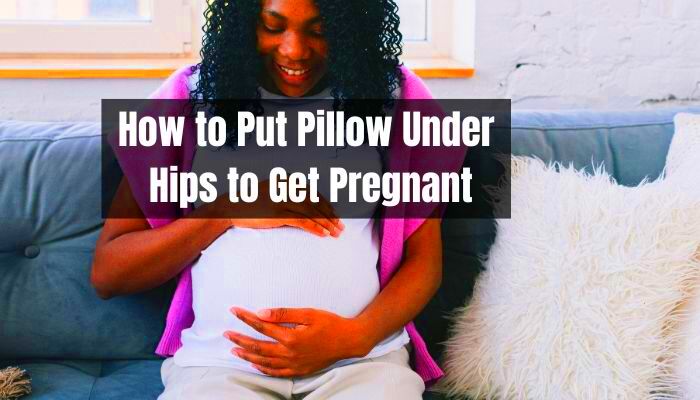When you're trying to get pregnant, every detail matters. Fertility is influenced by various factors, from lifestyle choices to timing, and even positioning during intercourse. Many women explore different methods and tips to help increase their chances of conception. One simple yet effective method involves positioning a pillow under your hips. It’s a small change that might make a big difference. While there are no guarantees in the journey to becoming a parent, understanding these small adjustments can give you a better chance. In this guide, we’ll explore how a pillow under your hips can help improve fertility.
How Pillow Positioning Can Benefit Fertility

Positioning a pillow under your hips after intercourse is often recommended by experts who believe it can help sperm reach the egg more effectively. When you lie down with your hips elevated, it can increase the chances of sperm traveling toward the cervix, making conception more likely. While this method isn't a magic solution, many women have found that it provides added comfort and support during their fertility journey. Here’s why this technique could benefit fertility:
- Gravity helps the sperm move: Elevating the hips positions the cervix to make it easier for sperm to enter the uterus.
- Improves sperm retention: The upright position helps to prevent sperm from flowing out after intercourse.
- Comfort during the post-intercourse period: It reduces any discomfort by providing better body alignment.
Although this method doesn’t guarantee pregnancy, many people find it to be a simple and relaxing way to potentially increase their chances of conception.
Steps to Properly Position a Pillow Under Your Hips

Using a pillow to support your hips is a simple technique, but it’s essential to position it correctly for the best possible results. Here’s a step-by-step guide to ensure you’re doing it right:
- Choose a comfortable pillow: A soft but firm pillow is ideal. It shouldn’t be too high or too low, just enough to raise your hips comfortably.
- Position the pillow: Place the pillow underneath your hips, ensuring your pelvis is tilted upward. This position helps gravity assist the sperm in moving toward the cervix.
- Lie down for at least 15-20 minutes: Stay in the position for about 20 minutes after intercourse to give the sperm time to travel toward the egg.
- Relax: Take the time to relax and enjoy the moment. It’s not just about the technique; your comfort and stress levels also play a role in fertility.
By following these steps, you can maximize the potential benefits of using a pillow to aid in fertility. Remember, it's just one small step in the broader picture of fertility, so be patient and persistent. Every journey to pregnancy is unique, and while pillow positioning is a helpful tool, it’s important to consider other factors too.
The Science Behind Pillow Positioning and Fertility
The idea behind using a pillow to elevate the hips stems from the principle of gravity. When you lie flat after intercourse, gravity can cause sperm to flow back out of the cervix. By elevating the hips, the angle of the body changes, making it easier for sperm to travel upward toward the uterus. Though research on pillow positioning itself is limited, many believe this simple adjustment may increase the chances of conception by providing a better environment for sperm to reach the egg.
Here’s how it works:
- Gravity assists sperm movement: Elevating your hips creates a position that may allow sperm to move more efficiently toward the cervix.
- Helps sperm retention: The pillow can help prevent sperm from flowing back out of the vagina after intercourse, potentially improving sperm retention.
- Optimizes cervical position: Elevating your hips may slightly tilt the cervix, which could allow sperm to enter more easily.
While there is no conclusive scientific proof that this method directly leads to pregnancy, it is based on simple physiological principles. Many women report feeling that this position increases their comfort and confidence during the fertility process, making it worth trying. As with any fertility method, patience is key, and it’s always best to consider pillow positioning as a part of a broader fertility plan.
Other Lifestyle Factors That Affect Fertility
Fertility is not just about positions or techniques—your overall lifestyle plays a significant role in your ability to conceive. Various factors, including diet, exercise, stress, and even sleep, can affect fertility. Making healthy changes in these areas can support your reproductive health and increase your chances of getting pregnant. Here are some important lifestyle factors to keep in mind:
- Diet: Eating a balanced diet rich in vitamins, minerals, and antioxidants is essential for maintaining good reproductive health. Focus on whole grains, fruits, vegetables, lean proteins, and healthy fats.
- Exercise: Regular moderate exercise can help maintain a healthy weight, balance hormones, and improve blood circulation—all of which can support fertility.
- Stress management: High stress levels can negatively affect hormones and ovulation. Consider practices like yoga, meditation, and mindfulness to reduce stress.
- Sleep: Getting enough rest each night is important for maintaining hormonal balance and overall health. Aim for at least 7-8 hours of sleep per night.
- Avoiding toxins: Environmental toxins, smoking, and excessive alcohol consumption can reduce fertility. Limiting exposure to these can help improve your chances of conception.
By incorporating healthy habits into your daily routine, you can support your reproductive system and improve your chances of conceiving. It’s also a good idea to consult with a healthcare professional for personalized advice and to rule out any underlying conditions that may be affecting your fertility.
When to Try Pillow Positioning for Fertility
Knowing when to try pillow positioning for fertility is just as important as understanding how to do it. Ideally, you should use the pillow positioning technique after every attempt at intercourse when you're actively trying to conceive. However, it’s essential to remember that this method alone will not guarantee pregnancy. It should be seen as a supplementary approach that can improve comfort and potentially aid in sperm retention.
Here’s when you might want to use this technique:
- After every attempt at intercourse: This is the most common recommendation. It’s believed that positioning the pillow immediately after intercourse may help give sperm the best chance of traveling toward the egg.
- During your most fertile days: It’s particularly helpful to try pillow positioning during your ovulation period when you are most fertile.
- When you’re feeling stressed or uncomfortable: If you feel that you’re not comfortable during or after intercourse, using a pillow can provide support, making the process more relaxed and less stressful.
It’s important to have realistic expectations when trying this method. While it can improve comfort and potentially help sperm retention, it’s just one factor in a much bigger picture. Don't be discouraged if you don’t get pregnant right away. Be patient, maintain a healthy lifestyle, and keep trying. If you find that conception is taking longer than expected, consider speaking with a healthcare provider for more guidance.
Potential Benefits of Using a Pillow for Fertility
Using a pillow to elevate your hips is a simple, natural method that many women try when they're trying to get pregnant. While there's no scientific guarantee that this technique will result in pregnancy, there are several potential benefits to consider. Many women find that it helps with comfort, enhances their fertility efforts, and provides a relaxing way to optimize their chances. Let’s explore some of the main benefits:
- Supports sperm retention: Elevating your hips after intercourse may help keep sperm inside the vagina longer, improving the chances of sperm reaching the egg.
- Improves comfort: For some, the posture adjustment with a pillow can be more comfortable after intercourse, helping them relax and reduce stress, which is important for fertility.
- Enhances natural sperm movement: By positioning the body at an angle, you may help gravity assist in moving sperm toward the cervix, potentially increasing the chances of conception.
- Low cost and simplicity: This is a simple, cost-free method that doesn't require medication or invasive treatments. It's easy to try and can be used alongside other fertility methods.
- No side effects: Since it's a natural approach, there are no known side effects of using a pillow for fertility, making it a safe option to experiment with.
Although using a pillow isn’t a scientifically proven "fertility booster," it’s a safe and easy addition to your routine. As part of a broader approach to conception, it might just improve your odds in a subtle but meaningful way.
What Experts Say About Pillow Positioning and Fertility
Experts have mixed opinions about using a pillow for fertility. While many healthcare professionals agree that there is no strong scientific evidence to support it as a proven method for conception, some believe that the technique could offer benefits in certain cases. Understanding what experts say can help you decide if this method is right for you.
Here’s a summary of expert opinions:
- Not a magical solution: Most doctors agree that while pillow positioning can’t guarantee pregnancy, it may aid in making the process more comfortable and could potentially help sperm retention.
- Gravity and sperm movement: Some experts believe that by elevating the hips, you might help gravity assist sperm movement toward the cervix. However, others suggest this benefit is minimal and doesn't replace other more proven fertility strategies.
- Comfort is key: Many experts acknowledge that comfort and relaxation play an essential role in fertility. The pillow positioning technique can help relieve discomfort after intercourse, allowing women to relax and reduce stress, which could improve overall fertility.
- Individual differences: Fertility is highly individual. Some women may find that the technique helps them feel more aligned and relaxed, while others might not notice much difference.
- Holistic fertility approach: Experts recommend taking a comprehensive approach to fertility that includes healthy lifestyle habits such as diet, exercise, stress management, and regular medical check-ups, alongside natural methods like pillow positioning.
Ultimately, while experts may not completely endorse this technique as a cure for infertility, many agree that it’s a harmless and inexpensive method to try as part of a broader fertility strategy.
Frequently Asked Questions
Here are some common questions about using a pillow for fertility, answered to help clarify any confusion you may have:
- How long should I keep the pillow under my hips?
It’s generally recommended to keep the pillow under your hips for about 15-20 minutes after intercourse. This gives sperm time to travel toward the egg. - Does the pillow position really help with conception?
While there’s no scientific proof that the pillow position directly leads to pregnancy, many people find it helps with sperm retention and comfort, which can support fertility efforts. - Can I use any pillow?
It’s best to use a soft, but firm pillow that can comfortably elevate your hips. You don’t need anything too fancy—just something that creates a gentle incline. - Should I try this method every time I have intercourse?
Yes, it can be helpful to try the pillow positioning method after every attempt to maximize the chances of conception, especially during your most fertile days. - Can pillow positioning be harmful?
There are no known harmful effects of using a pillow for fertility. It’s a non-invasive, simple technique that many women use to make the process more comfortable. - Should I combine this with other fertility treatments?
Yes, pillow positioning can be used as a supplementary method. It’s not a replacement for medical advice or fertility treatments, but it can be part of a holistic approach to improving your chances of conception.
If you’re still unsure about whether pillow positioning is right for you, it’s always a good idea to speak with your healthcare provider. They can offer personalized advice based on your specific fertility needs and goals.
Conclusion
Using a pillow to elevate your hips is a simple and natural technique that many women explore while trying to conceive. While it isn’t a guaranteed method, it can help with sperm retention and make the process more comfortable, which can be beneficial in your fertility journey. The science behind it suggests that gravity might assist sperm movement, and the slight tilt created by the pillow could optimize the chances of sperm reaching the egg.
However, it’s essential to keep in mind that fertility is influenced by many factors, and pillow positioning should be seen as one part of a broader approach. A healthy lifestyle, including a balanced diet, regular exercise, and managing stress, plays a crucial role in improving fertility. Always consult with a healthcare provider for personalized advice and guidance throughout your journey to conception. Patience and persistence are key, and using a pillow for fertility could be a simple step to take in hopes of enhancing your chances of becoming pregnant.











